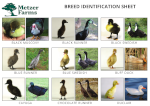
Use this table of goose breeds to compare all the different types of geese for sale at Metzer Farms. This data comes from our experience on the farm, feedback from customers, and information gathered from researchers. With so many breeds offered at Metzer Farms, we want you to make the most informed choice. Depending if you want a goose specifically for meat production, foraging, show, a pet, or one of the many other reasons people raise geese, this will help you find the most suitable breed for you.
 Download our breed identification chart.
Download our breed identification chart.
 Download our breed identification chart.
Download our breed identification chart.
Click/tap an attribute name to compare that attribute across breeds. Click/tap it again
to show all attributes.
Breed
Temperament
Weight1
Egg Production2
Mothering
Egg Size3
Fertility4
APA Class
Conservation Status5
Our Show Quality6
Flying Ability
Origin
Weeding
Temperament
Noisier
Weight1
12.50 - 15.50 lbs
Egg Production2
35 - 45 /year
Mothering
Good
Egg Size3
9.25 in
Fertility4
85 %
APA Class
N/A
Conservation Status5
Plenty
Our Show Quality6
Flying Ability
Maybe
Origin
China
Weeding
Good
Temperament
Noisier
Weight1
9.00 - 10.50 lbs
Egg Production2
30 - 45 /year
Mothering
Poor
Egg Size3
8.75 in
Fertility4
85 %
APA Class
Light
Conservation Status5
Watch
Our Show Quality6
Good
Flying Ability
Maybe
Origin
China
Weeding
Excellent
Temperament
Very Calm
Weight1
14.00 - 16.00 lbs
Egg Production2
25 - 35 /year
Mothering
Good
Egg Size3
9.25 in
Fertility4
65 %
APA Class
Medium
Conservation Status5
Watch
Our Show Quality6
Good
Flying Ability
Low
Origin
USA
Weeding
Good
Temperament
Calm
Weight1
15.00 - 17.00 lbs
Egg Production2
20 - 30 /year
Mothering
Good
Egg Size3
9.25 in
Fertility4
75 %
APA Class
Heavy
Conservation Status5
No Rank
Our Show Quality6
Average
Flying Ability
Low
Origin
USA
Weeding
Good
Temperament
Calm
Weight1
15.00 - 20.00 lbs
Egg Production2
35 - 45 /year
Mothering
Good
Egg Size3
9.75 in
Fertility4
80 %
APA Class
Heavy
Conservation Status5
No Rank
Our Show Quality6
Above Average
Flying Ability
Low
Origin
Germany
Weeding
Good
Temperament
Calm
Weight1
15.00 - 18.00 lbs
Egg Production2
35 - 50 /year
Mothering
Good
Egg Size3
9.50 in
Fertility4
85 %
APA Class
Conservation Status5
No Rank
Our Show Quality6
Flying Ability
Low
Origin
France
Weeding
Good
Temperament
Very Calm
Weight1
18.00 - 25.00 lbs
Egg Production2
16 - 25 /year
Mothering
Fair
Egg Size3
9.50 in
Fertility4
55 %
APA Class
Heavy
Conservation Status5
Watch
Our Show Quality6
Good
Flying Ability
None
Origin
England
Weeding
Below Average
Temperament
Very Calm
Weight1
13.00 - 15.00 lbs
Egg Production2
20 - 25 /year
Mothering
Good
Egg Size3
9.25 in
Fertility4
60 %
APA Class
Medium
Conservation Status5
Threatened
Our Show Quality6
Good
Flying Ability
Low
Origin
USA
Weeding
Good
Temperament
Calm
Weight1
11.50 - 14.00 lbs
Egg Production2
20 - 30 /year
Mothering
Good
Egg Size3
9.00 in
Fertility4
70 %
APA Class
Light
Conservation Status5
Critical
Our Show Quality6
Good
Flying Ability
Low
Origin
Italy
Weeding
Good
Temperament
Calm
Weight1
11.00 - 13.50 lbs
Egg Production2
13 - 18 /year
Mothering
Fair
Egg Size3
9.25 in
Fertility4
45 %
APA Class
Medium
Conservation Status5
Threatened
Our Show Quality6
Good
Flying Ability
None
Origin
Central Europe
Weeding
Good
Temperament
Noisier
Weight1
16.00 - 20.00 lbs
Egg Production2
20 - 30 /year
Mothering
Good
Egg Size3
9.50 in
Fertility4
75 %
APA Class
Heavy
Conservation Status5
Watch
Our Show Quality6
Good
Flying Ability
None
Origin
China
Weeding
Below Average
Temperament
Calm
Weight1
14.00 - 16.00 lbs
Egg Production2
25 - 30 /year
Mothering
Good
Egg Size3
9.50 in
Fertility4
80 %
APA Class
Conservation Status5
Watch
Our Show Quality6
Flying Ability
Low
Origin
France
Weeding
Good
Temperament
Noisier
Weight1
10.00 - 15.00 lbs
Egg Production2
40 - 55 /year
Mothering
Poor
Egg Size3
9.00 in
Fertility4
88 %
APA Class
Light
Conservation Status5
Watch
Our Show Quality6
Below Average
Flying Ability
Maybe
Origin
China
Weeding
Excellent
1. These are the weights of our breeders during lay. For maximum egg production, their weight has been controlled.
2. The lower numbers are if no artificial lights are used, the upper numbers are if artificial lights are used to maintain 17 hours of light during lay.
3. Average circumference in inches measured around the ends.
4. This is the average fertility we get from our breeders during an entire season of lay (35-45 weeks of lay).
5. The Livestock Conservancy ranks most poultry breeds on how rare they are. For more information, visit The Livestock Conservatory.
6. Summary of comments from waterfowl judges that have visited our farm.